16.7E: Ejercicios para la Sección 16.7
- Page ID
- 116727
En los ejercicios 1 - 6, sin utilizar el teorema de Stokes, se calcula directamente tanto el flujo de\(curl \, \vecs F \cdot \vecs N\) sobre la superficie dada como la integral de circulación alrededor de su límite, asumiendo que todos están orientados en sentido horario.
1. \(\vecs F(x,y,z) = y^2\,\mathbf{\hat i} + z^2\,\mathbf{\hat j} + x^2\,\mathbf{\hat k}\);\(S\) es la porción de primer octante del plano\(x + y + z = 1\).
2. \(\vecs F(x,y,z) = z\,\mathbf{\hat i} + x\,\mathbf{\hat j} + y\,\mathbf{\hat k}\);\(S\) es hemisferio\(z = (a^2 - x^2 - y^2)^{1/2}\).
- Responder
- \(\displaystyle \iint_S (curl \, \vecs F \cdot \vecs N) \, dS = \pi a^2\)
3. \(\vecs F(x,y,z) = y^2\,\mathbf{\hat i} + 2x\,\mathbf{\hat j} + 5\,\mathbf{\hat k}\);\(S\) es hemisferio\(z = (4 - x^2 - y^2)^{1/2}\).
4. \(\vecs F(x,y,z) = z\,\mathbf{\hat i} + 2x\,\mathbf{\hat j} + 3y\,\mathbf{\hat k}\);\(S\) es el hemisferio superior\(z = \sqrt{9 - x^2 - y^2}\).
- Responder
- \(\displaystyle \iint_S (curl \, \vecs F \cdot \vecs N) \, dS = 18 \pi\)
5. \(\vecs F(x,y,z) = (x + 2z)\,\mathbf{\hat i} + (y - x)\,\mathbf{\hat j} + (z - y)\,\mathbf{\hat k}\);\(S\) es una región triangular con vértices\((3, 0, 0), \, (0, 3/2, 0),\) y\((0, 0, 3).\)
6. \(\vecs F(x,y,z) = 2y\,\mathbf{\hat i} + 6z\,\mathbf{\hat j} + 3x\,\mathbf{\hat k}\);\(S\) es una porción de paraboloide\(z = 4 - x^2 - y^2\) y está por encima del\(xy\) plano.
- Responder
- \(\displaystyle \iint_S (curl \, \vecs F \cdot \vecs N) \, dS = -8 \pi\)
En los ejercicios 7 - 9, utilice el teorema de Stokes\(\displaystyle \iint_S (curl \, \vecs F \cdot \vecs N) \, dS\) para evaluar los campos vectoriales y la superficie.
7. \(\vecs F(x,y,z) = xy\,\mathbf{\hat i} - z\,\mathbf{\hat j}\)y\(S\) es la superficie del cubo\(0 \leq x \leq 1, \, 0 \leq y \leq 1, \, 0 \leq z \leq 1\), a excepción de la cara donde\(z = 0\) y usando el vector normal de la unidad exterior.
8. \(\vecs F(x,y,z) = xy\,\mathbf{\hat i} + x^2 \,\mathbf{\hat j} + z^2 \,\mathbf{\hat k}\); y\(C\) es la intersección de paraboloide\(z = x^2 + y^2\) y plano\(z = y\), y utilizando el vector normal exterior.
- Responder
- \(\displaystyle \iint_S (curl \, \vecs F \cdot \vecs N) \, dS = 0\)
9. \(\vecs F(x,y,z) = 4y\,\mathbf{\hat i} + z \,\mathbf{\hat j} + 2y \,\mathbf{\hat k}\); y\(C\) es la intersección de la esfera\(x^2 + y^2 + z^2 = 4\) con el plano\(z = 0\), y utilizando el vector normal exterior.
10. Utilice el teorema de Stokes para evaluar\(\displaystyle \int_C \big[2xy^2z \, dx + 2x^2yz \, dy + (x^2y^2 - 2z) \, dz\big],\) dónde\(C\) está la curva dada por\(x = \cos t, \, y = \sin t, \, 0 \leq t \leq 2\pi\), atravesada en la dirección de aumento\(t.\)
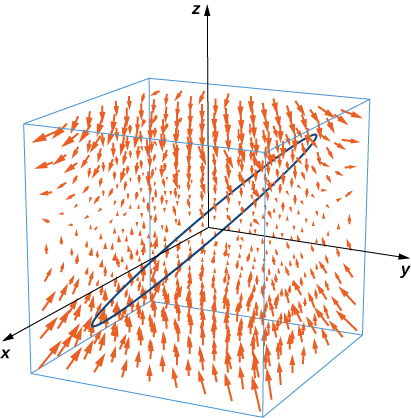
- Responder
- \(\displaystyle \int_C \vecs F \cdot dS = 0\)
11. [T] Use a computer algebraic system (CAS) and Stokes’ theorem to approximate line integral \(\displaystyle \int_C (y \, dx + z \, dy + x \, dz),\) where \(C\) is the intersection of plane \(x + y = 2\) and surface \(x^2 + y^2 + z^2 = 2(x + y)\), traversed counterclockwise viewed from the origin.
12. [T] Use a CAS and Stokes’ theorem to approximate line integral \(\displaystyle \int_C (3y\, dx + 2z \, dy - 5x \, dz),\) where \(C\) is the intersection of the \(xy\)-plane and hemisphere \(z = \sqrt{1 - x^2 - y^2}\), traversed counterclockwise viewed from the top—that is, from the positive \(z\)-axis toward the \(xy\)-plane.
- Answer
- \(\displaystyle \int_C \vecs F \cdot dS = - 9.4248\)
13. [T] Use a CAS and Stokes’ theorem to approximate line integral \(\displaystyle \int_C [(1 + y) \, z \, dx + (1 + z) x \, dy + (1 + x) y \, dz],\) where \(C\) is a triangle with vertices \((1,0,0), \, (0,1,0)\), and \((0,0,1)\) oriented counterclockwise.
14. Use Stokes’ theorem to evaluate \(\displaystyle \iint_S curl \, \vecs F \cdot dS,\) where \(\vecs F(x,y,z) = e^{xy} cos \, z\,\mathbf{\hat i} + x^2 z\,\mathbf{\hat j} + xy\,\mathbf{\hat k}\), and \(S\) is half of sphere \(x = \sqrt{1 - y^2 - z^2}\), oriented out toward the positive \(x\)-axis.
- Answer
- \(\displaystyle \iint_S \vecs F \cdot dS = 0\)
15. [T] Use a CAS and Stokes’ theorem to evaluate \(\displaystyle \iint_S (curl \, \vecs F \cdot \vecs N) \, dS,\) where \(\vecs F(x,y,z) = x^2 y\,\mathbf{\hat i} + xy^2 \,\mathbf{\hat j} + z^3 \,\mathbf{\hat k}\) and \(C\) is the curve of the intersection of plane \(3x + 2y + z = 6\) and cylinder \(x^2 + y^2 = 4\), oriented clockwise when viewed from above.
16. [T] Use a CAS and Stokes’ theorem to evaluate \(\displaystyle \iint_S curl \, \vecs F \cdot dS,\) where \(\vecs F(x,y,z) = \left( \sin(y + z) - yx^2 - \dfrac{y^3}{3}\right)\,\mathbf{\hat i} + x \, \cos (y + z) \,\mathbf{\hat j} + \cos (2y) \,\mathbf{\hat k}\) and \(S\) consists of the top and the four sides but not the bottom of the cube with vertices \((\pm 1, \, \pm1, \, \pm1)\), oriented outward.
- Answer
- \(\displaystyle \iint_S curl \, \vecs F \cdot dS = 2.6667\)
17. [T] Use a CAS and Stokes’ theorem to evaluate \(\displaystyle \iint_S curl \, \vecs F \cdot dS,\) where \(\vecs F(x,y,z) = z^2\,\mathbf{\hat i} + 3xy\,\mathbf{\hat j} + x^3y^3\,\mathbf{\hat k}\) and \(S\) is the top part of \(z = 5 - x^2 - y^2\) above plane \(z = 1\) and \(S\) is oriented upward.
18. Use Stokes’ theorem to evaluate \(\displaystyle \iint_S (curl \, \vecs F \cdot \vecs N) dS,\) where \(\vecs F(x,y,z) = z^2\,\mathbf{\hat i} + y^2\,\mathbf{\hat j} + x\,\mathbf{\hat k}\) and \(S\) is a triangle with vertices \((1, 0, 0), \, (0, 1, 0)\) and \((0, 0, 1)\) with counterclockwise orientation.
- Answer
- \(\displaystyle \iint_S (curl \, \vecs F \cdot \vecs N)dS = -\dfrac{1}{6}\)
19. Use Stokes’ theorem to evaluate line integral \(\displaystyle \int_C (z \, dx + x \, dy + y \, dz),\) where \(C\) is a triangle with vertices \((3, 0, 0), \, (0, 0, 2),\) and \((0, 6, 0)\) traversed in the given order.
20. Use Stokes’ theorem to evaluate \(\displaystyle \int_C \left(\dfrac{1}{2} y^2 \, dx + z \, dy + x \, dz \right),\) where \(C\) is the curve of intersection of plane \(x + z = 1\) and ellipsoid \(x^2 + 2y^2 + z^2 = 1\), oriented clockwise from the origin.
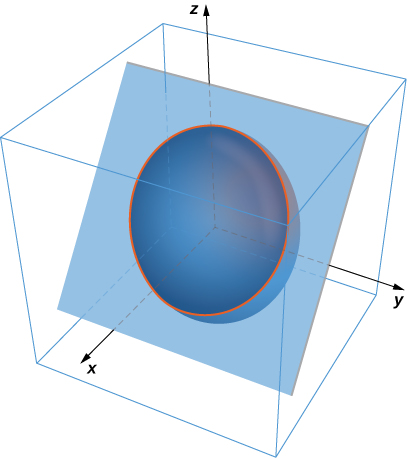
- Responder
- \(\displaystyle \int_C \left(\dfrac{1}{2} y^2 \, dx + z \, dy + x \, dz \right) = - \dfrac{\pi}{4}\)
21. Utilice el teorema de Stokes para evaluar\(\displaystyle \iint_S (curl \, \vecs F \cdot \vecs N) dS,\) dónde\(\vecs F(x,y,z) = x\,\mathbf{\hat i} + y^2\,\mathbf{\hat j} + ze^{xy}\,\mathbf{\hat k}\) y\(S\) es la parte de la superficie\(z = 1 - x^2 - 2y^2\) con\(z \geq 0\), orientada en sentido antihorario.
22. Utilice el teorema de Stokes para el campo vectorial\(\vecs F(x,y,z) = z\,\mathbf{\hat i} + 3x\,\mathbf{\hat j} + 2z\,\mathbf{\hat k}\) donde\(S\)\(C\) es superficie\(z = 1 - x^2 - 2y^2, \, z \geq 0\)\(x^2 + y^2 = 1\), es círculo límite y\(S\) está orientado en la\(z\) dirección positiva.
- Responder
- \(\displaystyle \iint_S (curl \, \vecs F \cdot \vecs N)dS = -3\pi\)
23. Usa el teorema de Stokes para el campo vectorial\(\vecs F(x,y,z) = - \dfrac{3}{2} y^2\,\mathbf{\hat i} - 2 xy\,\mathbf{\hat j} + yz\,\mathbf{\hat k}\), donde\(S\) está esa parte de la superficie del plano\(x + y + z = 1\) contenida dentro del triángulo\(C\) con vértices\((1, 0, 0), \, (0, 1, 0),\) y\((0, 0, 1),\) atravesada en sentido antihorario según se ve desde arriba.
24. Se sabe que una cierta trayectoria cerrada\(C\) en el plano\(2x + 2y + z = 1\) se proyecta sobre el círculo unitario\(x^2 + y^2 = 1\) en el\(xy\) plano. Dejar\(C\) ser una constante y dejar\(\vecs R(x,y,z) = x\,\mathbf{\hat i} + y\,\mathbf{\hat j} + z\,\mathbf{\hat k}\). Usar el teorema de Stokes para evaluar\(\displaystyle \int_C(c \,\mathbf{\hat k} \times \vecs R) \cdot dS.\)
- Responder
- \(\displaystyle \int_C (c \,\mathbf{\hat k} \times \vecs R) \cdot dS = 2\pi c\)
25. Usa el teorema de Stokes y deja\(C\) ser el límite de superficie\(z = x^2 + y^2\) con\(0 \leq x \leq 2\) y\(0 \leq y \leq 1\) orientado con normal orientado hacia arriba. Definir\(\vecs F(x,y,z) = \big(\sin (x^3) + xz\big) \,\mathbf{\hat i} + (x - yz)\,\mathbf{\hat j} + \cos (z^4) \,\mathbf{\hat k}\) y evaluar\(\int_C \vecs F \cdot dS\).
26. Dejar\(S\) ser hemisferio\(x^2 + y^2 + z^2 = 4\) con\(z \geq 0\), orientado hacia arriba. Let\(\vecs F(x,y,z) = x^2 e^{yz}\,\mathbf{\hat i} + y^2 e^{xz} \,\mathbf{\hat j} + z^2 e^{xy}\,\mathbf{\hat k}\) Ser un campo vectorial. Usar el teorema de Stokes para evaluar\(\displaystyle \iint_S curl \, \vecs F \cdot dS.\)
- Responder
- \(\displaystyle \iint_S curl \, \vecs F \cdot dS = 0\)
27. Let\(\vecs F(x,y,z) = xy\,\mathbf{\hat i} + (e^{z^2} + y)\,\mathbf{\hat j} + (x + y)\,\mathbf{\hat k}\) y let\(S\) ser la gráfica de función\(y = \dfrac{x^2}{9} + \dfrac{z^2}{9} - 1\) con\(z \leq 0\) orientada para que el vector normal\(S\) tenga un componente y positivo. Usar el teorema de Stokes para calcular la integral\(\displaystyle \iint_S curl \, \vecs F \cdot dS.\)
28. Usa el teorema de Stokes para evaluar\(\displaystyle \oint \vecs F \cdot dS,\) dónde\(\vecs F(x,y,z) = y\,\mathbf{\hat i} + z\,\mathbf{\hat j} + x\,\mathbf{\hat k}\) y\(C\) es un triángulo con vértices\((0, 0, 0), \, (2, 0, 0)\) y\(0,-2,2)\) orientado en sentido antihorario cuando se ve desde arriba.
- Responder
- \(\displaystyle \oint \vecs F \cdot dS = -4\)
29. Utilice la integral de superficie en el teorema de Stokes para calcular la circulación de campo\(\vecs F,\)\(\vecs F(x,y,z) = x^2y^3 \,\mathbf{\hat i} + \,\mathbf{\hat j} + z\,\mathbf{\hat k}\) alrededor de la\(C,\) cual se encuentra la intersección de cilindro\(x^2 + y^2 = 4\) y hemisferio\(x^2 + y^2 + z^2 = 16, \, z \geq 0\), orientada en sentido antihorario cuando se ve desde arriba.
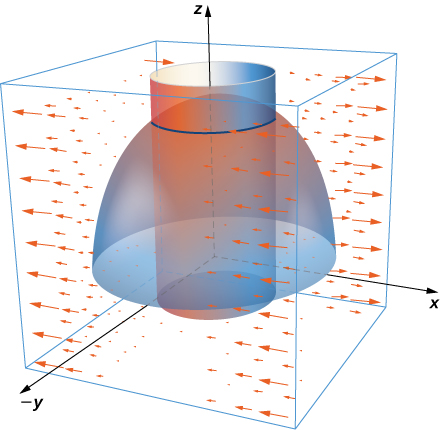
30. Usar el teorema de Stokes para calcular\(\displaystyle \iint_S curl \, \vecs F \cdot dS.\) where \(\vecs F(x,y,z) = \,\mathbf{\hat i} + xy^2\,\mathbf{\hat j} + xy^2 \,\mathbf{\hat k}\) and \(S\) is a part of plane \(y + z = 2\) inside cylinder \(x^2 + y^2 = 1\) and oriented counterclockwise.
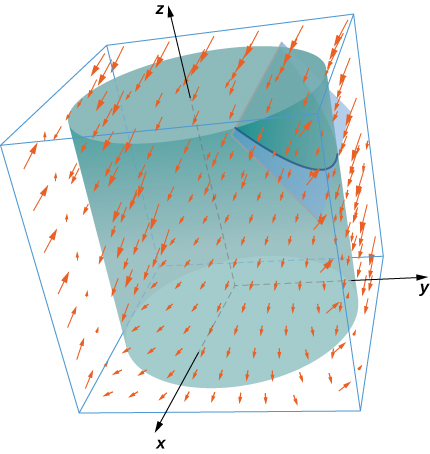
- Responder
- \(\displaystyle \iint_S curl \, \vecs F \cdot dS = 0\)
31. Utilice el teorema de Stokes para evaluar\(\displaystyle \iint_S curl \, \vecs F \cdot dS,\) dónde\(\vecs F(x,y,z) = -y^2 \,\mathbf{\hat i} + x\,\mathbf{\hat j} + z^2\,\mathbf{\hat k}\) y\(S\) es la parte del plano\(x + y + z = 1\) en el octante positivo y orientada en sentido antihorario\(x \geq 0, \, y \geq 0, \, z \geq 0\).
32. Dejar\(\vecs F(x,y,z) = xy\,\mathbf{\hat i} + 2z\,\mathbf{\hat j} - 2y\,\mathbf{\hat k}\) y dejar\(C\) ser la intersección de plano\(x + z = 5\) y cilindro\(x^2 + y^2 = 9\), que se orienta en sentido antihorario cuando se ve desde la parte superior. Calcular la integral de línea de\(\vecs F\) sobre\(C\) usando el teorema de Stokes.
- Responder
- \(\displaystyle \iint_S curl \, \vecs F \cdot dS = -36 \pi\)
33. [T] Usa un CAS y deja\(\vecs F(x,y,z) = xy^2\,\mathbf{\hat i} + (yz - x)\,\mathbf{\hat j} + e^{yxz}\,\mathbf{\hat k}\). Usa el teorema de Stokes para calcular la integral de superficie de curl\(\vecs F\) sobre superficie\(S\) con orientación hacia adentro que consiste en un cubo\([0,1] \times [0,1] \times [0,1]\) con el lado derecho faltante.
34. Dejar\(S\) ser elipsoide\(\dfrac{x^2}{4} + \dfrac{y^2}{9} + z^2 = 1\) orientado en sentido antihorario y dejar\(\vecs F\) ser un campo vectorial con funciones componentes que tienen derivadas parciales continuas.
- Responder
- \(\displaystyle \iint_S curl \, \vecs F \cdot \vecs N = 0\)
35. Dejar\(S\) ser la parte de paraboloide\(z = 9 - x^2 - y^2\) con\(z \geq 0\). Verificar el teorema de Stokes para el campo vectorial\(\vecs F(x,y,z) = 3z\,\mathbf{\hat i} + 4x\,\mathbf{\hat j} + 2y\,\mathbf{\hat k}\).
36. [T] Utilice un CAS y el teorema de Stokes para evaluar\(\displaystyle \oint \vecs F \cdot dS,\) si\(\vecs F(x,y,z) = (3z - \sin x) \,\mathbf{\hat i} + (x^2 + e^y) \,\mathbf{\hat j} + (y^3 - \cos z) \,\mathbf{\hat k}\), donde\(C\) esta la curva dada por\(x = \cos t, \, y = \sin t, \, z = 1; \, 0 \leq t \leq 2\pi\).
- Responder
- \(\displaystyle \oint_C \vecs F \cdot d\vecs{r} = 0\)
37. [T] Utilice un teorema de CAS y Stokes para evaluar\(\vecs F(x,y,z) = 2y\,\mathbf{\hat i} + e^z\,\mathbf{\hat j} - \arctan x \,\mathbf{\hat k}\) con\(S\) como una porción de paraboloide\(z = 4 - x^2 - y^2\) cortada por el\(xy\) plano -orientado en sentido antihorario.
38. [T] Utilice un CAS para evaluar\(\displaystyle \iint_S curl (F) \cdot dS,\) dónde\(\vecs F(x,y,z) = 2z\,\mathbf{\hat i} + 3x\,\mathbf{\hat j} + 5y\,\mathbf{\hat k}\) y\(S\) es la superficie paramétricamente por\(\vecs r(r,\theta) = r \, \cos \theta \,\mathbf{\hat i} + r \, \sin \theta \,\mathbf{\hat j} + (4 - r^2) \,\mathbf{\hat k} \, (0 \leq \theta \leq 2\pi, \, 0 \leq r \leq 3)\).
- Responder
- \(\displaystyle \iint_S curl (F) \cdot dS = 84.8230\)
39. Dejar\(S\) ser paraboloide\(z = a (1 - x^2 - y^2)\), para\(z \geq 0\), donde\(a > 0\) es un numero real. Vamos\(\vecs F(x,y,z) = \langle x - y, \, y + z, \, z - x \rangle\). ¿Para qué valor (s) de\(a\) (si los hay)\(\displaystyle \iint_S (\vecs \nabla \times \vecs F) \cdot \vecs n \, dS\) tiene su valor máximo?
Para los ejercicios de aplicación 40 - 41, el objetivo es evaluar\(\displaystyle A = \iint_S (\vecs \nabla \times \vecs F) \cdot \vecs n \, dS,\) dónde\(\vecs F = \langle xz, \, -xz, \, xy \rangle\) y\(S\) es la mitad superior del elipsoide\(x^2 + y^2 + 8z^2 = 1\), dónde\(z \geq 0\).
40. Evalúe una integral de superficie sobre una superficie más conveniente para encontrar el valor de\(A.\)
- Responder
- \(\displaystyle A = \iint_S (\vecs \nabla \times \vecs F) \cdot \vecs n \, dS = 0\)
41. Evaluar\(A\) usando una integral de línea.
42. Toma paraboloide\(z = x^2 + y^2\), para\(0 \leq z \leq 4\), y córtalo con avión\(y = 0\). Dejar\(S\) ser la superficie que queda para\(y \geq 0\), incluyendo la superficie plana en el\(xz\) plano. Dejar\(C\) ser el semicírculo y segmento de línea que delimitó la tapa de\(S\) en plano\(z = 4\) con orientación en sentido antihorario. Vamos\(\vecs F = \langle 2z + y, \, 2x + z, \, 2y + x \rangle\). Evaluar\(\displaystyle \iint_S (\vecs \nabla \times \vecs F) \cdot \vecs n \, dS.\)
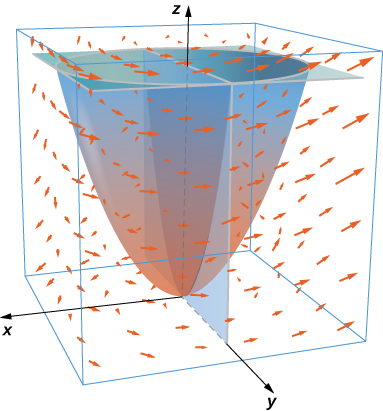
- Responder


